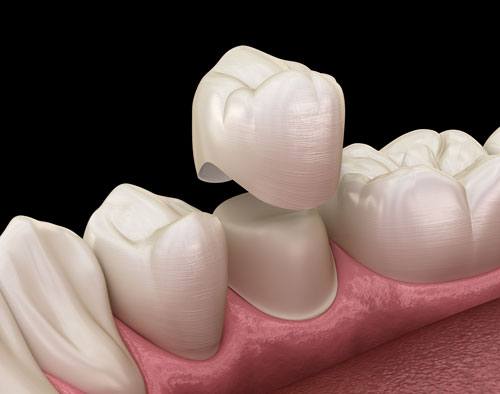What Are Crowns and Why Would I Need One?
A crown is a restorations used to cover, or “cap,” a tooth to restore it to its normal shape and size; the purpose of a crown is to strengthen and protect the tooth. Crowns are most often used for teeth that are cracked or fractured, broken, worn down or have portions destroyed by tooth decay too large to be replaced by a filling alone. Depending on how much tooth structure has been lost, it may be necessary to replace some of the lost tooth structure with an additional procedure called a crown build-up to provide a foundation for the crown.
Which Material Is Best?
Gold was one of the first materials used for crowns and is still an option today. Gold has a long track record of great success; however, many people prefer to have a tooth-colored crown that blends in perfectly.
Any tooth colored crown will be made either partially or entirely of porcelain; early tooth-colored crowns had porcelain on the outside and metal on the inside. Because of the metal, the edge of the crown was very dark, and, unfortunately, this dark edge frequently became visible over time, which made the tooth look strange.
All-porcelain crowns were subsequently developed in order to blend in better and remove the dark metal. These crowns mimic the translucency of natural teeth and can blend in perfectly. Some of the earliest all-porcelain crowns had problems with breaking, but dental porcelains have advanced tremendously in the last 20 years and are now extremely strong. https://www.youtube.com/watch?v=2ZRfQK6Ipb0
How Are Crowns Made?
In preparation for a crown, your dentist will remove the outer portion of your tooth to accommodate the thickness of the crown. If the tooth already has a filling, part of the material may be left in place to serve as a foundation for the crown.
After the preparation is complete, an impression is taken using a clay-like material, which provides us with an exact model of your prepared tooth so that your crown can be custom made. Your unique impression allows our local laboratory technician to examine all aspects of your bite and jaw movements and sculpt your crown so that your bite and jaw movements function normally once the crown is placed — this usually takes about two to three weeks. We will fabricate a temporary crown for you to wear to keep your tooth protected until your permanent crown arrives.
Crowns are permanently cemented in place to fully cover the portion of your tooth above your gum line. In effect, the crown is now your tooth’s new outer surface.
How Do I Care for My Crown?
It is especially important to brush and floss around your crowns (we recommend at least twice a day) to remove plaque from the area where the gum meets the tooth. When plaque accumulates in this area, it can cause dental decay at the root of your newly crowned tooth (below the gum line) as well as gum disease.
Porcelain restorations are as strong as your natural teeth, but just like your natural teeth, they can chip or break if abused. We recommend that you avoid certain things that would even damage natural tooth structure, such as biting ice, fingernails, hard candies, chicken bones or rib bones.
To learn more about how a crown can improve the health, function and beauty of your smile, we welcome your call at 360-876-0445 or visit to Fisher Distinctive Dentistry in Port Orchard, Washington, where Dr. Devin Fisher and Dr. Zack Bergevin look forward to helping you maintain a healthy smile!
